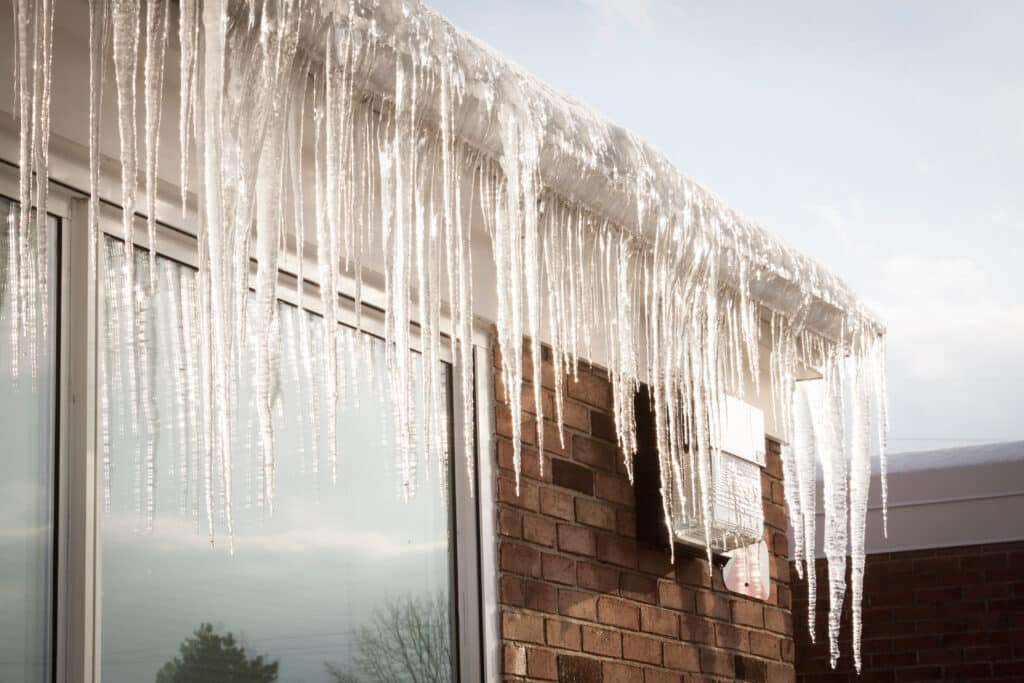Winter Roof Maintenance Tips for Asphalt Shingle Roofs
In this blog, you’ll learn four essential maintenance tasks to do in the winter to protect your asphalt shingle roof.

In this blog, you’ll learn four essential maintenance tasks to do in the winter to protect your asphalt shingle roof.

Maintaining your roof in the winter is integral to ensuring a safe and functional home. The ripping winds and freezing temperatures are brutal forces that can damage your roof’s shingles, possibly allowing water to infiltrate your home’s interior.
While asphalt shingle roofs are typically low-maintenance, there are a few tasks you should plan to do throughout the year, especially in late fall, just before winter comes.
Make a habit of inspecting your roof from the ground, looking for missing or torn shingles, metal flashing that’s been blown loose, sagging or overflowing gutters, or blocked downspouts. If you can do so safely, you should periodically check your attic for damp or wet insulation, blistered plywood, excessive heat, or sagging framing members.
If you notice any of these issues, it’s wise to contact your roofing contractor promptly. Keep in mind that any damage that occurs in the warmer seasons will likely be exacerbated during winter, so roofing issues should always be addressed as soon as possible to avoid further damage and costly repairs down the road.
In addition to your routine inspections, you should have your roof professionally inspected at least twice a year, preferably in the spring after the last winter freeze and again in the fall before winter hits.

All roofing structures have weight limits. Accumulated snow and ice can be very heavy and possibly cause structural damage to your roofing system. Some visible signs of this include cracked drywall in your home or attic rafters that have bent under pressure. So, removing snow and ice is important if they accumulate excessively.
And while you may be tempted to remove it yourself, know that roofing is an inherently dangerous vocation, and you could incur serious bodily injury if something goes wrong. When you remove snow from your roof, it’s always best to do it from the ground, if possible.
Additionally, don’t use metal shovels or other abrasive tools when removing snow, which can damage asphalt shingles. In almost every case, it’s better to call a professional to have excessive snow and ice removed from your roof—this will keep you and your roof much safer.
When the snow on your roof melts during the daytime, it will travel downhill toward the gutters, which are most likely filled with snow. That water freezes when the temperatures drop at night, prohibiting the gutters from functioning properly. With repetitive freezing and thawing, built-up ice (an ice dam) can form in your gutters, in the valleys of your roof, and on low-pitched areas that don’t allow water to run off quickly.
An ice dam can also trap moisture under the surface of the shingles, which can then permeate through the sheeting and into your attic space. The best way to prevent ice dams from forming in the first place is to ensure your gutter system functions correctly, your attic is properly insulated and ventilated, and you’re in the habit of inspecting your roof for signs of snow or ice issues. If you do notice an ice dam, call an expert.

Drainage issues and subsequent water damage are much more likely to occur if you fail to keep your gutters and downspouts clean. Gutters that don’t drain freely will hold water longer, increasing the probability of ice dam formation.
Having gutter guards installed is a very smart, cost-effective idea to keep your gutter system free of leaves, animal nests, pine needles, and other obstructive materials.
If you don’t have gutter guards installed, periodically remove leaves and debris with your hands, a trowel, or a gutter scoop. Remember—be careful when using a ladder, and always try to remove debris from the ground rather than from the roof.

First, always take extra steps to ensure your personal safety when hanging holiday lights on your gutters. When you’re on the ladder:
Now, to prevent damage to your roof, use plastic hooks and clips to attach the lights to your roof and gutters. Using nails and staples is not recommended because they can create holes in your shingles, leading to mold and mildew. Staples are also harder to remove.
Staying on top of maintenance will help to keep your home dry, warm, and safe. Plus, it’ll save you a lot of money by preventing the need for expensive repairs.
If you’re not sure what to look for during visual inspections or don’t think you can safely remove ice dams, always contact a professional like L&S Home Improvements.
We’re a licensed and insured roofing company providing high-quality roofing services, including inspections, repairs, and ice dam removal, to our friends and neighbors in Southeast Michigan.
Contact us today to get started with a roof inspection.
